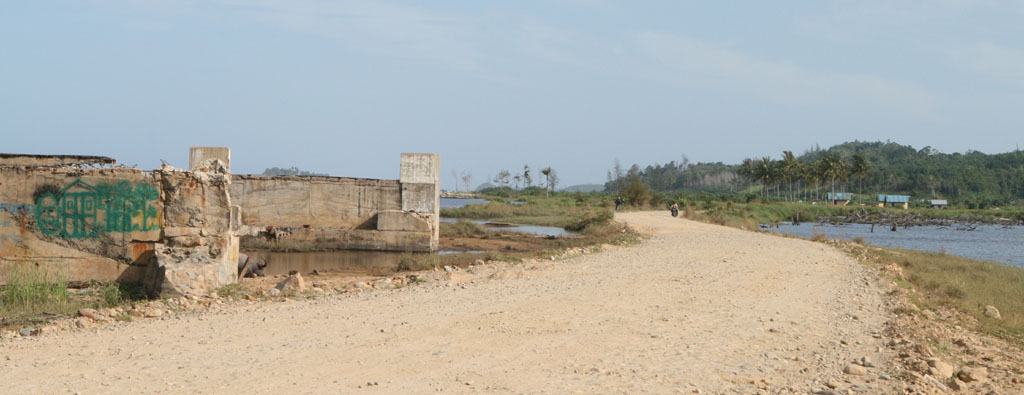Banda Aceh - Calang v.v.
8 uur over 180 km / 8 hours for 100 ml
|

|
|
|
|
|
Deze pre-tsunami kaart stelt het makkelijk voor:
volg gewoon de gele hoofdweg van Banda Aceh naar Calang.
|
 |
This pre-tsunami map makes things look easy:
just follow the yellow main road from Banda Aceh to Calang
|
|
|
Wat meer detail:
links: Banda Aceh tot Lam No
rechts: Lam No tot Calang
|
 |
Some more detail:
left: Banda Aceh until Lam No
right: Lam No until Calang
|
|
|
Wie de nummering van de foto's goed bekijkt zal zien dat e.e.a. hier beslist niet op volgorde staat. Omdat we niet wisten wat ons te wachten stond en je niet overal kunt stoppen voor het nemen van foto's, heb ik de meeste plaatjes geschoten op de terugweg. Voor het verhaal maakt het niet veel uit.
Wat wel uitmaakt, tot mijn grote frustratie, is dat de kaarten van dit gebied gewoon niet meer kloppen. Achteraf kom je dan tot de conclusie dat ik voor deze reis een GPS ontvanger had moeten kopen, zodat de foto's beter te lokaliseren waren geweest.
Maar weet je veel als verwende westerling waar je in terecht komt.
Nou: letterlijk in een nieuws-item van het 8 uur Journaal.
|
On close inspection one will find that the picture numbering is out of order.
Not knowing what to expect and the inability to make numerous photo stops, caused me to take most photos on the way back. For the story itself this is irrelevant.
What is relevant however, is the fact that the maps for this area are no longer correct. In hindsight I should have bought a GPS receiver before this trip, thus enabling the localization of the pictures.
But being a spoiled westerner you have no idea what you're getting into.
As a matter of fact: In a news item of the Nine O'clock news.
|
|
|
Na enig zoekwerk vond ik deze oude stafkaart op het web. Oud blijkt ook uit het feit dat Banda Aceh nog wordt aangegeven als Kutaradja. Maar prima voor mijn doel.
Volg de als rode lijn aangegeven weg aan de kust van Banda Aceh via Lhoknga naar Lamseuninio, net daaronder waar 165 staat gaat de weg over een rivier....
|
 + 1 + 1
|
After some effort I found this old map on the Internet. Old is also implied by the fact that Banda Aceh is indicated with its old name Kutaradja. But it is fine for my purpose.
Follow the red line, which is the coastal way from Banda Aceh passed Lhoknga to Lamseuninio, just where it says 165, the road passes over a river....
|
|
|
Dit is de rivier, met daarover een noodbrug, want de oorspronkelijke brug....
|
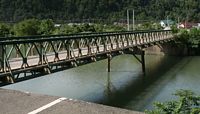 |
This is the river, with an emergency bridge, because the original bridge....
|
|
|
was een klein beetje weggespoeld.
Met dank aan Google, die van dit plekje een foto bleek te hebben van net na de tsunami
Dus © 2007 Google.
Het wrak van de brug ligt nog midden-onder aan de oever van de rivier. Te zien is ook dat de noodbrug al in aanbouw is.
Op deze foto is alleen op de hoge punten nog groene vegetatie over.
Let eens op de middenstreep van de weg en de donkere driehoek net onder het linker brughoofd.
|
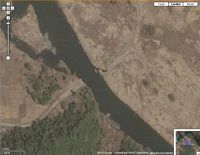 |
has been swept away.
With special thanks to Google, which appeared to have a photo from just after the tsunami.
So: © 2007 Google.
The wreckage of the bridge can be seen lying mid-under on the bank of the river. Clearly the building of the emergency bridge is already under way.
In this picture only vegetation on the higher lying areas remained.
Pay special attention on the white center line of the road and the dark triangle just below the left bridge head.
|
|
|
Die middenstreep staat er nog steeds en de donkere driehoek blijkt een stenen talud te zijn.
Ook op de lage punten is het alweer behoorlijk groen.
Ook hier weer die praktische instelling van de mensen hier: Het ongebruikte stuk weg is nu een badminton veld.
|
 + 1 + 1
|
The centerline is still there and the dark triangle appears to be a stone slope.
The lower areas are already covered with green vegetation again.
Again the practical sense of the people shows: The unused road is changed into a badminton field.
|
|
|
Na deze brug gaat de weg het kustgebergte in. De weg kronkelt, stijgt en daalt als een achtbaan, totdat we bij de rode ster zijn , Bineh Gle. Die ster is een uizichtspunt en laat daar nu net een koffietent staan.
|
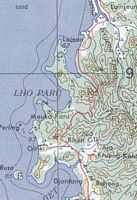 |
After this bridge the road enters a coastal mountain range. It curves and bends like a roller-coaster, until we reach the red star, Bineh Gle. The star is a lookout point and as it turns out we find a coffee joint over there
|
|
|
De blauwe tentjes links zijn de toiletten
|
 + 3 + 3
|
The blue shelters on the left are the toilets
|
|
|
Links naast de trappen staat aangegeven dat we van onderprovincie van Aceh wisselen
Aceh .. naar Aceh Jaya
|
 |
Left from the stairs is indicated that we cross into the next subdistrict of Aceh
Aceh .. to Aceh Jaya
|
|
|
Als ik het door aardbevingen zwaar aangetaste uitzichtspunt beklim is dit het uitzicht naar het zuidoosten. De zwartgrauwe stranden zijn een voorbode van wat komen gaat.
We komen op dit punt echter niet aan de kust, zoals van hier al te zien is, is er beneden geen weg (meer)
De noodweg loopt naar links landinwaarts om de riviermonding heen.
|
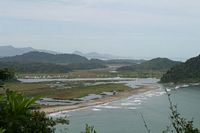 + 3 + 3
|
When I climb up to the earthquake devastated lookout point, this is the view towards the southeast, the greyblack beaches are a premonition of things to come.
However we will not reach the coast at this point, as can be seen from here already, there is no road (anymore) down below.
The emergency road turns left inland, around the river estuary.
|
|
|
De veerpont bij Lam No
Bij Lam No is er iets speciaals aan de hand.
Het Indonesische leger heeft de noodweg waarover we rijden in ongeveer drie maanden uit de grond gestampt. Daarbij ging het alleen maar om het bereikbaar maken van het rampgebied. Deze weg is op sommige plaatsen dwars door oude dorpen en daarmee door privé grond van mensen gelegd, zonder dat die voor het verlies van hun grond zijn gecompenseerd.
Nu wordt met Amerikaanse hulp een nieuwe weg aangelegd van Banda Aceh naar Calang. Voor de grond die daarvoor nodig is, is keurig betaald. Je voelt hem dus al wel aankomen: er zijn mensen die zich tekort gedaan voelen omdat zij voor de noodweg niets gekregen hebben.
Bij Lam No zit zo iemand en die sluit gewoon de noodweg af, heft tol en zorgt voor veel oponthoud.
Een vertraging van twee uur is heel gewoon. Voor vrachtverkeer is er geen alternatief, voor ons wel....
|
The Ferry at Lam No
Something special is going on at Lam No.
The Indonesian army pounded the emergency road out of the ground in about three months. The only objective was to provide access to the disaster area. At places it runs straight through old villages and with that through peoples properties, without them being compensated.
At this moment, with American aid, a new coastal way is being constructed from Banda Aceh to Calang. People are being paid properly for the ground required. As you may expect: there are people upset about them not being compensated for the ground taken by the emergency road.
By Lam No lives such a person and he simply blocks the road, demands toll and causes a lot of delays.
Two hours delay is quite common. Freight trucks have no alternative, we do....
|
|
|
Van de overkant komt iets aandobberen wat als het aanlegt....
|
 |
From the over side something floats our way, which as it comes ashore....
|
|
|
een pontje blijkt te zijn.
|
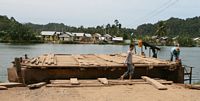 |
turns out to be a ferry
|
|
|
De eerste auto gaat erop, heus die balken zijn breed genoeg.
|
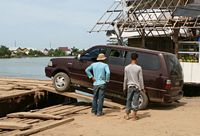 |
The first car boards, really those logs are wide enough.
|
|
|
Zover mogelijk doorrijden a.u.b. er moet nog meer mee!
|
 |
Go forward as far as possible please, there are more travelers
|
|
|
Komt u maar
|
 |
Come please
|
|
|
Goed zo, zo mogen we het zien, netjes aansluiten.
|
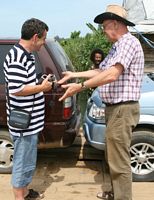 |
Now thats how we like it, no wasted space.
|
|
|
Zie je wel, er is nog genoeg ruimte over achter de linker auto.
|
 + 1 + 1
|
See: room to spare behind the car on the left.
|
|
|
Dan start onze Rasta Captain de motor en gaan we varen.
|
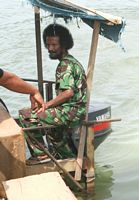 |
The the Afro captain starts the engine and we cast off.
|
|
|
Dat deze buitenboordmotor niet voor dit soort werk geschikt is, is wel te zien aan het verschrikkelijke caviteren van de schroef.
Een lager toerental met grotere schroef zou heel wat efficiënter zijn.
|
 |
That outboard engine is clearly not made for this job, as can be seen from the enormous cavitation of the propeller.
Lower rpm and a bigger diameter propeller would work miracles.
|
|
|
Rivier met uitzicht: boven landinwaarts, beneden naar de kust
|
 |
A river with a view: top land inward, bottom towards the coast
|
|
|
Kennelijk hebben we het gehaald
|
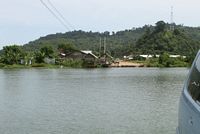 |
Apparently we made it
|
|
|
Die balk waarop je loopt ziet er behoorlijk stevig uit, nietwaar Conny?
|
 + 2 + 2
|
That log you're walking on looks mighty strong , right Conny?
|
|
|
Na Lam No (zuidoostelijk) volgt er een kleine laagvlakte, dan weer een uitloper van bergen tot aan de kust, waarna er beneden Lho Kruet een vrij grote laagvlakte volgt die doorloopt tot voorbij Calang. In deze laagvlakte had de tsunami min of meer vrij spel....
|
 |
After Lam No (southeast) follows a small lowland, than an offshoot from the mountains, after which below Lho Kruet follows a real big lowland area,which runs all the way past Calang. In these lowlands there was nothing to stop the tsunami....
|
|
|
De oude kaart vermeldt hier: Coconut
|
 |
Here the old map indicates: Coconut
|
|
|
En dit is dus wat daar van over is
|
 + 6 + 6
|
And this is what's left
|
|
|
Dit kon dus niet uitblijven op deze weg
|
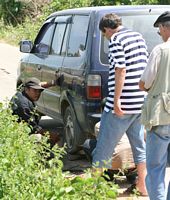 |
This was unavoidable on this road
|
|
|
Maar het is goed te weten dat geestelijke steun nooit ver weg is.
|
 |
But luckily spiritual support is alway close by.
|
|
|
Een eind verderop zien we dat het, door het teruglopende tsunami water, weggespoelde zand door de zee wordt teruggebracht en er spontaan duinen aan het ontstaan zijn.
|
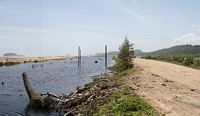 |
Further down the road we see that sand, swept away by the retreating tsunami wave, is brought back by the sea and sand dunes are forming.
|
|
|
Inclusief stuifzand
|
 |
Including drift-sand
|
|
|
We stoppen hier om te kijken naar de boompjes op de achtergrond. Deze zijn door USAID aangeplant om het stuiven tegen te gaan, maar dreigen nu te verdrinken in het zand.
|
 + 2 + 2
|
We stop to have a look at the small trees in the background. These were planted by USAID to reduce the drift-sand, but are now at risk to drown in the sand.
|
|
|
Een andere noodbrug, nu bij ..
|
 + 2 + 2
|
Another emergency bridge, this time at ..
|
|
|
Naast de noodbrug aan de rivier ligt een van de kwekerijen, bij de rode tank rechtsboven.
Ziet u dat noodbruggetje links voor, we moesten uitstappen zodat de chauffeur de lege auto er overeen kon rijden. Dat werd hem toch te link en deed een poging om om te rijden. Met mijn camera nog in de auto. Sorry, geen foto's van de kwekerij!
|
 |
Besides the bridge lies one of the greeneries, near the red tank at the right top.
See that makeshift bridge front left. We got out of the car so the driver could pass it. As it turned out he decided it was to risky and took off for a detour. With my camera still in the car. Sorry, no pictures of the greenery!
|
|
|
Ook in deze puinhoop is geestelijke hulp altijd dichtbij
|
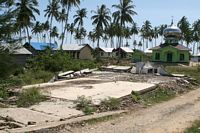 + 4 + 4
|
In this mess also: spiritual support close by
|
|
|
Een laatste stop voor Calang, met bamisoep en koffie
|
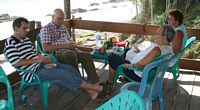 |
Last break before Calang, with noodle soup and coffee
|
|
|
en een fraai uitzicht.
|
 + 2 + 2
|
and a beautiful view.
|
|
|
En dan Calang.
Sorry, maar ik ben kritisch op mezelf, hier heb ik duidelijk te weinig foto's gemaakt. Achteraf bezien dan.
Na alle verwoestingen onderweg wordt je wat terughoudend om steeds weer puinhopen te laten zien.
|
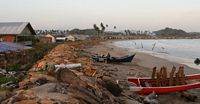 |
Finally Calang.
Sorry, I'm critical on myself, but I didn't take enough photos here. In hindsight that is.
After all devastation along the road, one hesitates to show still more ruins.
|
|
|
Niet wetende dat Google ook hier prima vergelijkingsmateriaal heeft.
Dit is Calang pre-tsunami. Op ongeveer een kwart van linksonder is een helwit dak te zien. Dat staat bovenop een afwateringskanaal wat naar boven loopt, links van een moskee en dan aan de andere kant van de weg naar rechts afbuigt. Tussen dak en moskee staat rechts van het kanaal een gebouw met een blauw dak. Dat is het camera standpunt van de vorige foto, kijkend naar rechts. (plek is gemarkeerd met een lichtblauwe punt)
Die dichte rij palmbomen is dus verdwenen, evenals een heel stuk strand.
Die dichte rij palmbomen is dus verdwenen, evenals een heel stuk strand.
|
 |
Not knowing that Google again has excellent comparison material.
This is Calang pre-tsunami. At about a quarter from left under a white roof is visible. It is on top of a small drainage canal, which runs towards the top, left from a mosque and bends to the right on the other side of the road. Between roof and mosque, right from the canal stands a building with a blue roof. That's the point of view from the last picture, looking to the right. (spot marked with a light-blue dot)
The dense row of palm trees is all but gone, including a strip of the beach.
|
|
|
De andere lichtblauwe punt is ons hotel, waar deze auto voor staat.
Alle huizen die aan de overkant van de weg stonden zijn ook weg en nu vervangen door enkele noodwoningen, je kijkt nu vrijwel vrij uit naar zee
|
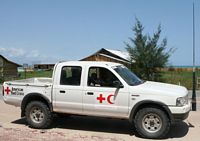 |
The other light-blue dot is our hotel, in front of which this car is parked.
All the houses across the street are gone and replaced by some emergency houses, the line of sight towards sea is clear.
|
|
|
Stompjes van de bomen staan nog op het strand.
En wat ik eigenlijk wilde fotograferen was die visser die z'n vangst uitlaadde
|
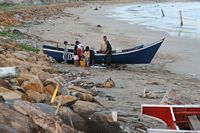 + 1 + 1
|
Tree roots are still standing on the beach.
And all I really wanted to portray was that fisherman unloading his catch.
|
|
Een waterbron voor Calang
A water source for Calang
|
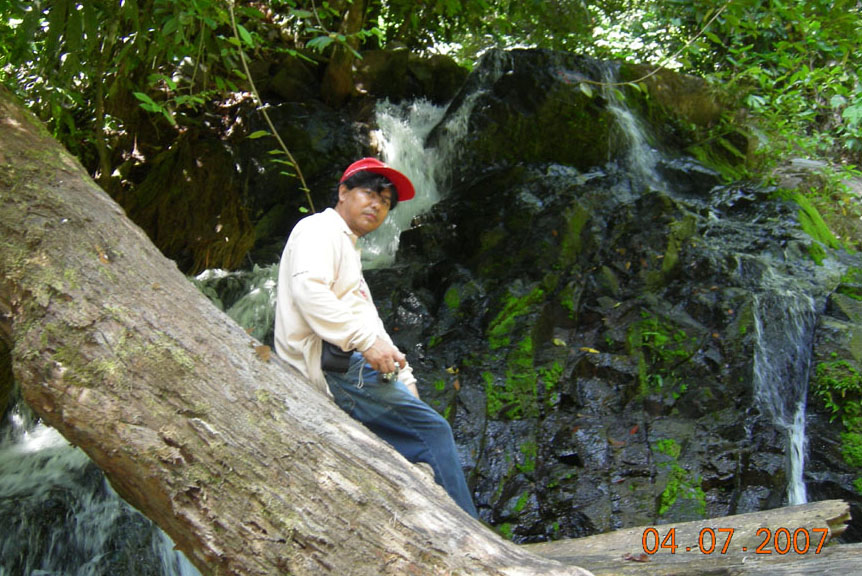
|
|
|
|
De dag na onze trip naar de bron gaan we weer terug naar Banda Aceh.
Hier staat de auto op de noodweg aan de kust, we kijken zuidoost.
|
 |
The day after our trip to the spring we head back to Banda Aceh.
Here we find the car parked on th emergency road on the coast, looking southeast.
|
|
|
en dit noordwest.
Die brug moet origineel over water gegaan zijn, waarschijnlijk de uitmonding van een rivier.
Kennelijk is ook hier het landschap zo veranderd, dat het water nu ergens anders naartoe loopt.
|
 |
and this is northwest.
That bridge must originally have crossed some water, probably the discharge of a river.
Apparently the scenery is changed so much, the water is flowing elsewhere now.
|
|
|
Dan maken we een stop bij Loh Kruet.
We wachten op de andere auto, alvorens onze opwachting te maken bij de leider van een project hier.
|
 |
Next stop is at Loh Kruet
Here we wait for the other car, before making our attendance with the manager of a project here.
|
|
|
Geeft mij de tijd om deze noodbrug wat nader te bekijken
|
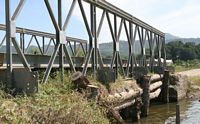 + 2 + 2
|
Gives me time to take a look at this emergency bridge
|
|
Loh Kruet
meer tuinen / more gardens
|

|
|
|
|
Als we wegrijden, zien we deze groep dorpsbewoners een pad herstellen....
|
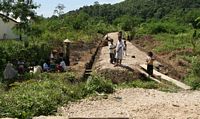 |
As we drive off, we see these villagers repairing a path....
|
|
|
met resten kapot koraal!
|
 |
with shreds of broken coral!
|
|
|
Een van de honderden kapotte bruggen, waar het water nu blijft is onduidelijk.
|
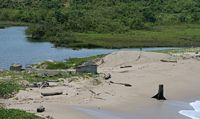 |
One of the hundreds broken bridges, where to the water flows now is unclear.
|
|
|
Maar deze plek is illustratief voor de situatie: de weg is weg, we gaan hier linksaf landinwaarts, tot een plek waar de rivier smal genoeg is voor een noodbrug. Aan de andere kant kom je dan terug naar de kust. Dat deel van de weg is zichtbaar boven het water bij die twee telefoonpalen.
Hemelsbreed 180 km wordt zo echt een trip van 8 uur.
|
 |
But this spot illustrates the situation: the road is gone, we turn left here inland, until we reach a spot where the river is small enough for an emergency bridge. On the other side one gets back to the coast. That part of the road can be seen above the water at those two telephone poles.
As the crow flies 120 miles, really becomes an 8 hour trip that way
|
|
|
Op een andere plek is de weg niet meer dan een karrenspoor zand om een rotspunt.
|
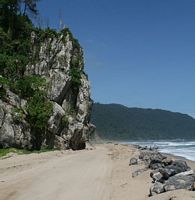 |
At another spot the road is a mere sand trail around a rock-edge.
|
|



 + 3
+ 3






 + 1
+ 1



 + 2
+ 2

 + 6
+ 6



 + 2
+ 2
 + 4
+ 4

 + 2
+ 2
 + 2
+ 2




